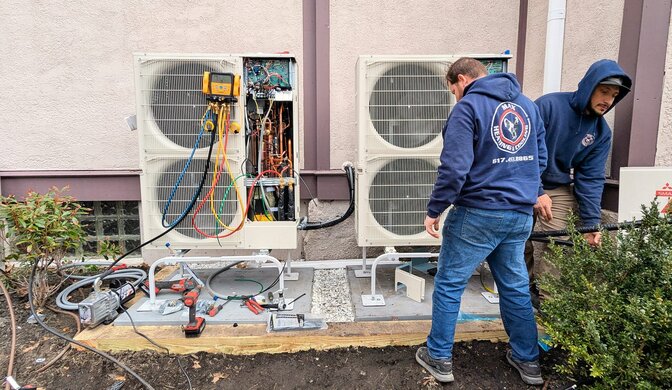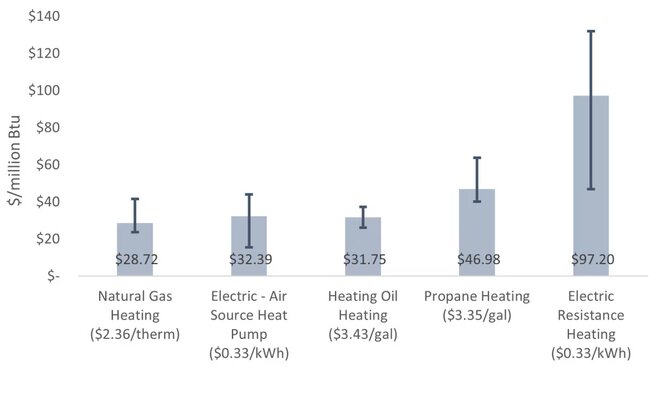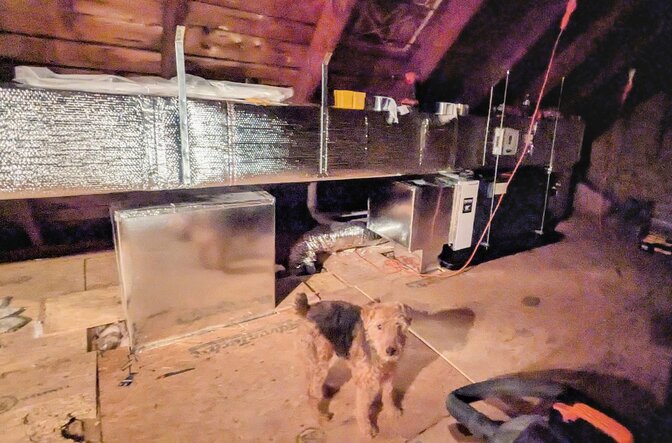I think my gas appliances are out to get me. Less than a year after my gas water heater dissolved into a puddle and left me without hot water for several days, I suddenly find myself writing these words in a cold house in the middle of a New England winter.
For better or worse, the time had come to retire the old gas heating system. I was going all in on heat pumps.
Right at the onset of the cold season, the two boilers in my basement began sputtering and stalling in a seemingly deliberate, coordinated act of sabotage. Once their impending doom was evident to me and confirmed by multiple contractors, I took the rather drastic step of ordering both boilers dismantled and taken off the property. While the contractors were at it, they also drained and removed the network of old steam pipes that had occupied the basement for nearly a century and a half. I decided to do all this while the ground outside was still frozen and large icy patches still lingered from the last snowstorm. I knew that I’d be depriving myself of a warm living space until the new system was operational, which was still a couple of weeks away. But that, friends, is the price of modernizing (and in the process, electrifying) my home. For better or worse, the time had come to retire the old gas heating system. I was going all in on heat pumps.

Why I switched from gas to a heat pump
Despite being very open about my career pivot to climate solutions—and documenting that journey on my personal blog—my own greenhouse gas emissions had nothing to do with the decision to switch to heat pumps. In fact, I resisted going fully electric until the last moment, trying as best I could to find a hybrid compromise that could pair a heat pump with our steam boiler. I hoped this would blend the cozy radiator warmth with improved air quality and reliable cooling in the summer. Unfortunately, given the particulars of my home, I could not find a solution that would be practical or economical.
Over the past two months, I explored options with nearly a dozen contractors. I did all the research and learning I possibly could, and then some. I learned far more than I ever cared to about BTUs, air handlers, ducted and ductless systems, refrigerant lines, air filtration, baseboards, radiators, heat loss and gain calculations, the dynamics of air flow, and much, much more. I did not come to the decision to entirely switch to heat pumps until it was clear that I would be adopting a more comfortable, more efficient, more modern, more flexible, and healthier heating and cooling system that would easily justify the investment.
The challenges of retrofitting an old home
I live in a Victorian-era single-family home just outside of Boston. It still retains many of the original features, like extensive woodwork and flooring, and a beautiful stained glass window slowly yielding to gravity, now visibly thicker at the bottom than at the top. These features give the house character; it is charming, quirky, and appropriately creaky. The bulky cast iron radiators and thick-walled black iron steam pipes were originally connected to a coal boiler, later converted to oil, and finally to gas during renovations by the previous owners twenty years ago. The house never had any ducts or air conditioning. Boston summers are hot and humid, and on the hottest days, the house swelters. For several years, we made it through the peak summer heat with a window A/C unit in one of the bedrooms. At the height of each of the past seven summers, we promised ourselves that next year we would finally install proper air conditioning. Eventually, a failing heating system forced us to act.
But retrofitting an old house isn’t easy. Lack of ductwork, solid framing, historic details, attics with little headroom, and other space constraints can make installation invasive and very costly. Many older homes also have outdated electrical systems that need upgrading to support modern HVAC loads.
Ducted vs. ductless: What worked for us
Typically, the easiest and cheapest solution for comfortable air conditioning is to install ductless mini-splits1. This is often the only practical option for new ductwork in homes without easily accessible spaces. Unfortunately, a ductless solution was a non-starter for us. We were after modern comfort, but unwilling to compromise the home’s Victorian-colonial character. Deploying bulky, bright (and frankly, unsightly) mini-splits throughout the house was a step we weren’t prepared to take.
Fortunately, we have an unfinished and relatively spacious attic and basement areas that could accommodate new ductwork to reach every room in the house. This would give us a central air system for heating and cooling with full zoning control. For the first time in its long history, our home could become a fully conditioned space, offering air filtration and precise year-round temperature control. Our only hesitation was giving up the coziness of the steam radiators, which we had come to enjoy. But then we started noticing how unevenly the radiators heated different parts of our home, how the living room was never quite warm enough while my office upstairs was too hot, and how we could never get the kitchen to the right temperature because it relied on a noisy baseboard fan too disruptive to run during conversations.
In the end, it was clear our old home deserved a modern HVAC system to make it truly comfortable. That’s when we turned to heat pumps.
Heat pump costs and savings
Heat pumps can be cheaper, but not always. Upgrading to a heat pump water heater last year was an easy choice because the total cost of ownership is much lower compared to a gas tank heater—the HPWH will pay for itself in just a few years. But that is not always the case with space heating. According to the Massachusetts Department of Energy Resources (DOER), heat pump heating costs in my area are roughly comparable to natural gas, possibly even slightly higher.

Source: Mass. DOER, via Laminar Research
The calculations I ran for my home align with this data, at around $25 per million BTU this winter, and $23 last winter (reflecting recent increases in natural gas prices). I am cautiously optimistic about my heating bills post-upgrade for two reasons:
- Steam heating is pretty inefficient, even compared to gas furnaces. Steam boilers make up a small share of gas heating in Massachusetts, meaning DOER’s cost data mostly reflect more efficient hot water boilers and furnaces. Given that, heat pumps should look comparatively more favorable for my particular situation.
- Starting in 2025, Massachusetts electric utilities will offer reduced rates for customers using heat pumps as their sole source of heating. This change could reduce winter electricity costs by 10%-20% (though, of course, who knows what the looming, stupid trade wars will do to future rates).
All told, after accounting for the addition of whole-home air conditioning, I fully expect our annual utility bills to rise. And then there’s the hefty installation cost of heat pumps, considerably higher than simply replacing our gas boilers—even after generous incentives like Mass Save’s $10,000 rebate, a $2,000 federal tax credit, and a 7-year, 0% interest loan.
It was clear our old home deserved a modern HVAC system to make it truly comfortable.
But in this case, we need to look beyond mere economics. A central heat pump system is a significant home upgrade, an investment that will enhance comfort and increase property value.

Overcoming fear and doubt when switching to a heat pump
Range anxiety is real. The toughest part of switching to a heat pump has been the FUD (fear, uncertainty, and doubt). For all the faults of our old gas heating system—and there were plenty—it was still the devil we knew. We had grown attached to our radiators: their charm fit our quirky home, the heat felt cozy, and we knew that they could handle harsh winters.
FUD is a major barrier to decarbonizing the built environment at scale. Completely changing how we heat and cool our homes is a big decision that demands a big budget. Yet there’s still a lot of uncertainty about how things will look, perform, and feel once the project is complete.
My experience has been no different. As appealing as heat pumps seem on paper, we won’t truly know how they will feel until we’ve parted with a sizeable chunk of savings and are deep into next winter. There are stories of poor installations and improperly sized systems (both undersized and oversized designs bring their own problems). A neighbor told me that on the coldest days, his heat pump struggles to push indoor temperatures above 18°C, forcing him to activate the backup furnace.
Completely changing how we heat and cool our homes is a big decision that demands a big budget.
But it is a fact that modern heat pumps can efficiently heat entire homes even in extreme cold. Cold-climate models are certified to operate comfortably down to -25°C and even lower. Some of the coldest places in the world, such as Norway, Sweden, Finland, and Quebec, are seeing high rates of heat pump adoption. In Maine, hundreds of thousands of residents are happily adopting heat pumps faster than anywhere else in the U.S.
Still, a kind of range anxiety persists. Did I thoroughly vet the contractor? Was the sizing calculation correct? Will the installation go smoothly? Will the equipment handle Boston’s extreme weather? Will it feel drafty? (We have a particular aversion to furnace-forced air.) Will it be noisy? Too dry? Too humid? Or am I just overthinking everything?
What it’s like living with a heat pump (so far)
As it turns out, my new heat pumps were finally switched on earlier today, and I already have answers to some of these questions. I’ll write more about what it’s like living with a heat pump, but suffice to say that as I feel the air around me gently warming to a cozy 22°C while the bitter wind whistles through the bare trees outside my window, I have no doubt that this was the right decision.
H2: Advice for homeowners considering the switch
Ready to replace your gas furnace with a high-efficiency heat pump? Start by connecting with a heat pump contractor in your area through The Switch Is On Pro Network. They’ll help you assess your home, choose the right system, and access thousands in incentives.
To make your project successful, you can follow this guide on how to hire a heat pump contractor and compare quotes.